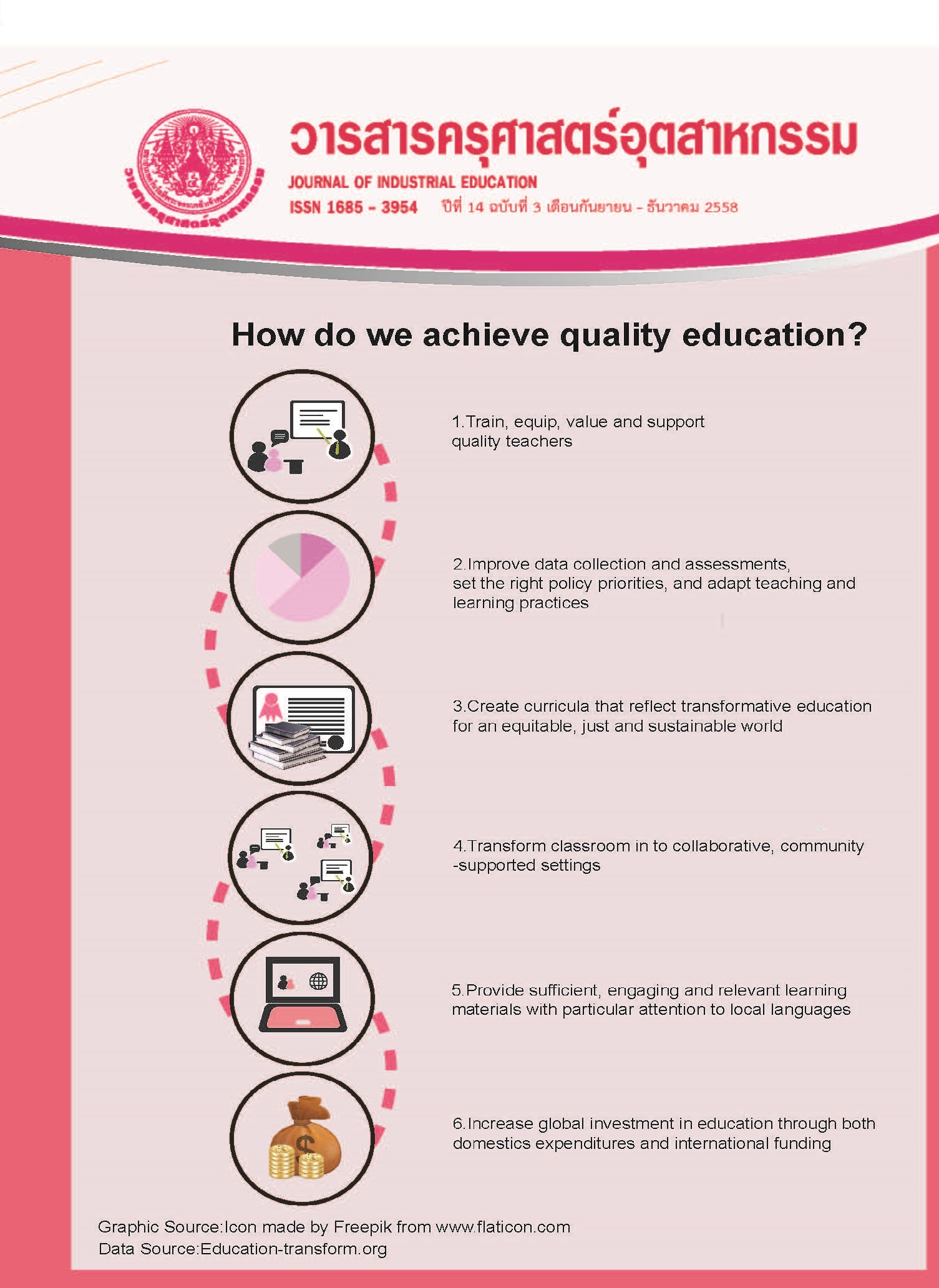The Effects of Learning Management using Augmented Reality with Cartoon Animation on Signs and Musical Symbols for Students in Secondary School
Main Article Content
Abstract
The purposes of this research were as follows; 1) to create and develop lesson plan using augmented reality with cartoon animation on sings and musical symbols for students in secondary school ,2) to determine the efficiency of learning management using augmented reality with cartoon animation on sings and musical symbols for students in secondary school, 3) to compare achievement between students learned through augmented reality with cartoon animation and those who learned with normal teaching, 4) to determine the satisfaction of the students learning with augmented reality with cartoon animation on sings and musical symbols.
The samples were randomly selected by Custer Sampling. They were divided into three groups. The first group was to find the efficiency of learning. The second group was experimented with augmented reality with cartoon animation, and compared the achievement scores. The third was a control group. The instruments used in this study were lesson plan using augmented reality, quality assessment tools, a satisfaction survey and achievement tests. The content validity (IOC) of the achievement test was 1.00 and the reliability was 0.86. The data were analyzed by mean, standard deviation and t-test (independent)
The results of this study were, 1) The efficiency of learning management using augmented reality with cartoon animation on signs and musical symbols was at 88.40:87.33 which met the standard criteria of 80/80, 2)the achievement scores of students learning with learning management using augmented reality with cartoon animation on signs and musical symbols was higher than those who studied in traditional method at the .05 level of significant, 3) the learners expressed the highest level of satisfaction towards the developed learning package (=4.65).
Article Details
"The opinions and contents including the words in papers are responsibility by the authors."
"ข้อคิดเห็น เนื้อหา รวมทั้งการใช้ภาษาในบทความถือเป็นความรับผิดชอบของผู้เขียน"
References
[2] รักษพล ธนานุวงศ์. 2555. สื่อเสริมการเรียนรู้โลกเสมือนผสานโลกจริง (Augmented Reality) เรื่อง การจมและลอย. ค้นเมื่อวันที่ 14 พฤษาคม 2557, จาก https://secondsci.ipst.ac.th.
[3] วิวัฒน์ มีสุวรรณ. 2556.การเรียนรู้ด้วยการสร้างโลกเสมือนผสานโลกจริงค้นเมื่อวันที่ 10 พฤษาคม 2557,จากhttps://www.tcithaijo.org/index.php/edujournal_nu/article/viewFile/9351/8462
[4] ADDIE Model. 2552.ทฤษฎีและหลักการออกแบบเว็บไซต์. ค้นเมื่อวันที่ 10 พฤษาคม 2557. จากhttps://202.29.15.37/wbt/menu_7_3.php.
[5] ชัยยงค์ พรหมวงศ์. 2543. เทคโนโลยีและสื่อการสอนเอกสารการสอนชุดวิชาเทคโนโลยีการศึกษา หน่วยที่ 1-4. นนทบุรี: มหาวิทยาลัยสุโขทัยธรรมาธิราช.
[6] Bloom Taxonomy. 1956. Bloom et al.'staxonomy of Educational Objectives,the classification of educational Goals –Handbook I: Cognitive Domain.New York: McKay.
[7] Likert, R. 1932. A Technique for the measurement of Attitude. Arch.Psychol. No. 140
[8] สถิรชาติ เรือนนาค. 2555. บทเรียนคอมพิวเตอร์ช่วยสอน เรื่อง การเขียนแบบทางสถาปัตยกรรม.วารสารครุศาสตร์อุตสาหกรรม, 11 (3), น.110-108.
[9] นันทรัตน์ กลิ่นหอม. 2555. การพัฒนาบทเรียนผ่านเครือข่ายอินเทอร์เน็ตเพื่อการทบทวน เรื่อง ระบบเครือข่ายคอมพิวเตอร์ วิชาเทคโนโลยีสารสนเทศเบื้องต้น. วารสารครุศาสตร์อุตสาหกรรม,11 (2), น.48-54.
[10] อัญชลี บุญฤทธิ์. 2554.ผลสัมฤทธิ์ทางการเรียนของผู้เรียนโดยใช้ห้องเรียนเสมือนจริง.วิทยานิพนธ์ปริญญาครุศาสตร์อุตสาหกรรมมหาบัณฑิต สาขาเทคโนโลยีสารสนเทศ มหาวิทยาลัยพระจอมเกล้าธนบุรี.
[11] อำนาจ ชนพิทักษ์. 2554.การเปรียบเทียบผลสัมฤทธิ์ทางการเรียน เรื่อง อุปกรณ์ทำงานและวาล์วในระบบนิวแมติกส์ระหว่างการใช้ชุดการเรียนเสมือนจริงกับการเรียนปกติ.วิทยานิพนธ์ครุศาสตร์อุตสาหกรรมมหาบัณฑิต สาขาครุศาสตร์ไฟฟ้า มหาวิทยาลัยพระจอมเกล้าธนบุรี.

